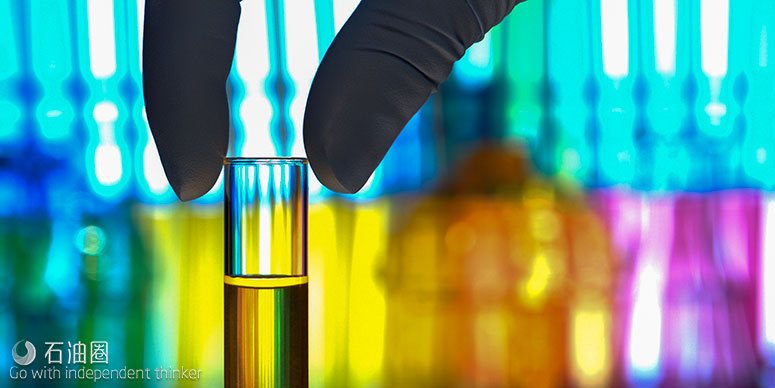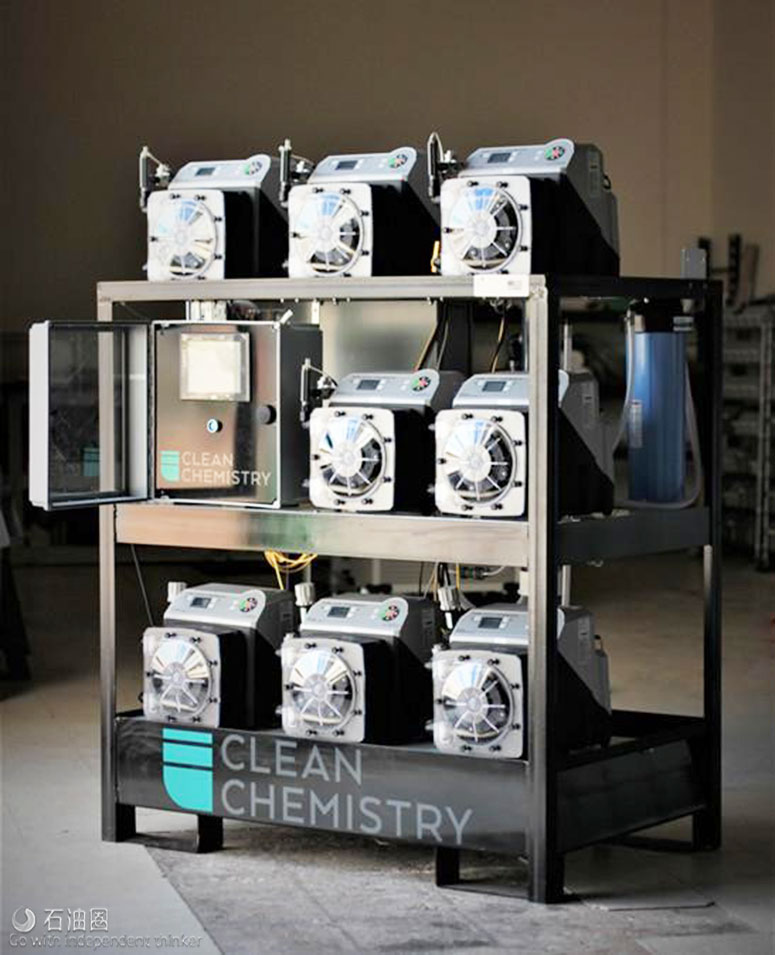Microbial control is a primary concern for completion water, and the industry is currently split right down the middle on how to solve it. Half of the industry uses oxidizers for a low-cost, fast bacteria kill. The other half uses
preservative chemistry as their only tool. This includes glutaraldehyde (glut), quaternary ammonium compounds (quat) and glut-quat blends. Preservative chemistry is very good at holding water biostatic for longer periods of time but is
more expensive and slower at the initial kill. But many HSE departments have blocked the oxidizers because the most pervasive oxidizer in upstream water has been chlorine dioxide, a volatile, flammable gas that represents a significant
exposure hazard and has caused numerous accidents at well pads and water treatment operations.
Clean Chemistry recently released a new oxidizer, PeroxyMAX, for upstream water treatment. PeroxyMAX is a 5.8% solution of sodium peracetate designed to deliver large concentrations of reactive oxygen species—singlet oxygen, superoxide
and hydroperoxyl radicals. The selectivity of this unique oxidant blend in a safe liquid formulation gives customers the horsepower they need without the hazards.
PeroxyMAX is the only chemistry capable of fast-acting, low-cost treatment on any water source with full automation and real-time quality control.
Safe, simple and automated
Inherently safer chemistry, process and automation enable cost reductions while delivering better performance and efficiency.
Safer chemistry. The product is a dilute solution of a peroxide salt that is essentially nonvolatile and odorless. Potential exposure is limited to direct contact with the liquid solution, which is generated and dispensed in a contained
process. Oxygen is slowly released from any unconsumed oxidant, leaving nontoxic biodegradable residuals that are generally regarded as safe.
Simple process. There are a number of safety features inherent to the chemical production process. On-demand production of the chemistry occurs by reacting three stable nonflammable feedstocks together in a specific process. The
generation systems contain less than 4 liters of product solution at any time; operate near atmospheric pressure; and are equipped with numerous automatic shutdown interlocks, alarms and notifications.
Automation. The solution is automatically metered at the needed rate into the water being treated, where it is consumed within minutes to hours as it generates reactive oxygen species. Dispensing rates are controlled by water treatment
process sensors such as inline flowmeters and oxidation-reduction potential sensors. The systems are networked for remote monitoring and control and collect data for full-time quality assurance and reporting.
The competition
Chlorine dioxide, the primary oxidant chemistry used for oilfield water treatment, is a highly toxic and flammable gas that is very corrosive in water solutions, particularly saline water. Chlorine dioxide also is an explosive gas above 10% by volume in air and is about 2.4 times heavier than air, so its release can quickly impact people in surrounding areas. It is rapidly released from water (vapor pressure greater than 1 atm) and is listed as immediately dangerous to life or health at 13.8 mg per cu. m (0.39 mg per cf), which is easily achieved in the head space of tanks and enclosed areas. Chlorine dioxide gas can accumulate in air pockets in transfer lines, which can cause line rupture and damage to equipment. Chlorine dioxide must be dosed as a gas into the water stream being treated, which significantly limits the treatment capacity range and configuration of a chlorine dioxide system. Automation and monitoring is offered with some chlorine dioxide treatment systems, but dispensing requires taking custody of the water stream being treated.
Peracetic acid is a volatile liquid provided in concentrated aqueous solutions (typically 10% to 15% by weight) in acetic acid and hydrogen peroxide that is unstable in hot environments, produces very irritating vapors to personnel and exhibits elevated vapor corrosion rates relative to PeroxyMAX. Peracetic acid is provided as a bulk chemical without the automation, process feedback and real-time quality assurance data necessary to provide a water treatment solution.
Low-cost deployment, large capacity
A single PeroxyMAX system has low power requirements with a small physical footprint and can treat 60 bbl/min (heavily contaminated produced water clarification) to 200 bbl/min (fresh/brackish water microbial control), depending on oxidant demand. The system can be contained in a small cargo trailer and requires only a single 120VAC 15A circuit (less than 1,800 W) to operate. Onshore water treatment service is provided at a single per-barrel price, discounted for increased monthly volumes per system.
The system also has an optional peripheral chemical dispensing system integrated with the primary automation and control system for dispensing other chemistries, including compatible water clarifiers, scale inhibitors and preservatives.
Smart water treatment platform
The rapidly evolving digital era of data-driven operations, automation and asset management in the oil field has enabled new levels of efficiency and increased productivity. Cost, performance and safety are mantras of oilfield
operations, and it is only with forward-thinking innovations that these needs can be met in all aspects of oilfield operations, including water sourcing, treatment and disposal asset management.
PeroxyMAX systems utilize in-line water treatment process sensors for automation and key performance indicators for each fixed or mobile system operation and are networked for dashboard access to live and historic data. Historic data can be provided for real-time treatment quality assurance, reporting, monitoring of trends and identifying causes of upsets during water treatment operations. Systems are programmed to automatically respond to changing water treatment chemical demand and provide notifications to operators of service needs.
The inherent safety, automation, process monitoring and data gathering combined in a smart treatment platform with this technology enables significant improvements in operational safety and reliability while reducing or virtually eliminating onsite labor costs for water treatment operations.

 石油圈
石油圈

